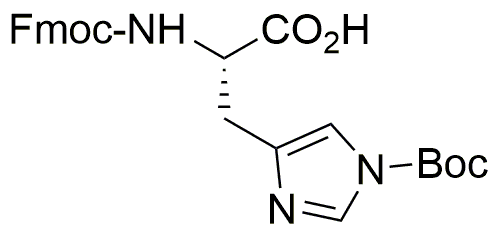Na-Fmoc-Nim-Boc-L-histidine is widely utilized in research focused on
- Peptide Synthesis: This compound serves as a key building block in the synthesis of peptides, particularly in solid-phase peptide synthesis, allowing researchers to create complex peptide sequences efficiently.
- Drug Development: It is used in the development of pharmaceuticals, especially in designing histidine-containing compounds that can act as enzyme inhibitors or modulators, which are crucial in treating various diseases.
- Bioconjugation: The chemical is valuable in bioconjugation techniques, where it helps in attaching biomolecules to surfaces or other molecules, enhancing the functionality of drugs and diagnostics.
- Protein Engineering: It plays a significant role in protein engineering, aiding in the modification of proteins to improve their stability and activity, which is essential in biotechnology applications.
- Research in Cancer Therapeutics: The compound is explored in cancer research for its potential to create targeted therapies, leveraging its ability to interact with specific biological targets in cancer cells.
General Information
Properties
Safety and Regulations
Applications
Na-Fmoc-Nim-Boc-L-histidine is widely utilized in research focused on
- Peptide Synthesis: This compound serves as a key building block in the synthesis of peptides, particularly in solid-phase peptide synthesis, allowing researchers to create complex peptide sequences efficiently.
- Drug Development: It is used in the development of pharmaceuticals, especially in designing histidine-containing compounds that can act as enzyme inhibitors or modulators, which are crucial in treating various diseases.
- Bioconjugation: The chemical is valuable in bioconjugation techniques, where it helps in attaching biomolecules to surfaces or other molecules, enhancing the functionality of drugs and diagnostics.
- Protein Engineering: It plays a significant role in protein engineering, aiding in the modification of proteins to improve their stability and activity, which is essential in biotechnology applications.
- Research in Cancer Therapeutics: The compound is explored in cancer research for its potential to create targeted therapies, leveraging its ability to interact with specific biological targets in cancer cells.
Documents
Safety Data Sheets (SDS)
The SDS provides comprehensive safety information on handling, storage, and disposal of the product.
Product Specification (PS)
The PS provides a comprehensive breakdown of the product’s properties, including chemical composition, physical state, purity, and storage requirements. It also details acceptable quality ranges and the product's intended applications.
Certificates of Analysis (COA)
Search for Certificates of Analysis (COA) by entering the products Lot Number. Lot and Batch Numbers can be found on a product’s label following the words ‘Lot’ or ‘Batch’.
Número de catálogo
Número de lote/lote
Certificates Of Origin (COO)
This COO confirms the country where the product was manufactured, and also details the materials and components used in it and whether it is derived from natural, synthetic, or other specific sources. This certificate may be required for customs, trade, and regulatory compliance.
Número de catálogo
Número de lote/lote
Safety Data Sheets (SDS)
The SDS provides comprehensive safety information on handling, storage, and disposal of the product.
DownloadProduct Specification (PS)
The PS provides a comprehensive breakdown of the product’s properties, including chemical composition, physical state, purity, and storage requirements. It also details acceptable quality ranges and the product's intended applications.
DownloadCertificates of Analysis (COA)
Search for Certificates of Analysis (COA) by entering the products Lot Number. Lot and Batch Numbers can be found on a product’s label following the words ‘Lot’ or ‘Batch’.
Número de catálogo
Número de lote/lote
Certificates Of Origin (COO)
This COO confirms the country where the product was manufactured, and also details the materials and components used in it and whether it is derived from natural, synthetic, or other specific sources. This certificate may be required for customs, trade, and regulatory compliance.


